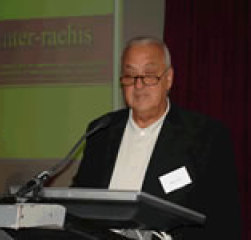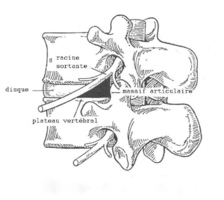
CERVICAL PERCUTANEOUS LASER DISC DECOMPRESSION
Eric GOZLAN(Paris), Valérie Lavignolle-Aurillac(Bordeaux)
ISMISS-Zurich, Jan. 2005
STUDY DESIGN:
A prospective study concerning 29 cases with cervical disc herniations was evaluated 3 months after PLDD.
OBJECTIVES:
To describe the technique and to evaluate the efficacy and safety of the Holmium YAG laser (LISA), in a population suffering from a radiculopathy secondary to a soft cervical herniation.
This study excluded sequestered fragments and important degenerative changes.
SUMMARY OF BACKGROUND DATA:
PLDD was first initiated by CHOY and ASCHER in 1986 using a Nd:YAG laser at lumbar level.
In Europe, the first cervical level case was performed by J.HELLINGER in 1991.
In 1993, W.SIEBERT published a very large study in SPINE, , establishing the codification of the technique at the different levels of the spine. He concluded that HO:YAG laser is safer and more efficient, giving its best results at the cervical level.
METHOD:
A prospective assessment of 29 patients was performed at 3 months after the PLDD.
The outcome was graded with an A.V.S. separately for the radicular and cervical pain.
We also graded the degree of the patient’s satisfaction by recording the excellent, very good and good results as a success, and the fair, poor and bad results as a failure.
RESULTS:
At 3 months post-operatively we noted that:
- The neurological signs had totally disappeared.
- Also, the average of the radicular pain was reduced by 77% on the AVS and the cervical pain by 57%.
- 72% of the patients (21/29) considered the result as a success.
The statistical analysis using the Signed Rank test was very significant (p < 10 -4). The patients operated with this technique had significantly improved at 3 months post-operatively.
No major complications appeared in this study except a local infection in our first case (no antibioprophylaxis) and neurological symptoms in another case, 6 weeks after PLDD. Both patients were operated with good final result.
CONCLUSION:
The preliminary results of this prospective controlled study are encouraging.
The statistical analysis showed a significant improvement at 3 months post-operatively.
This technique seems to be an interesting alternative to open surgery, being less invasive.
However, correct selection of patients is most important and the operator must be well trained to PLDD techniques.
The last generation of HO:YAG laser has made a real progress with regards to security.
The pain provocation during discography seems to have a prognostic value related to the good results.

